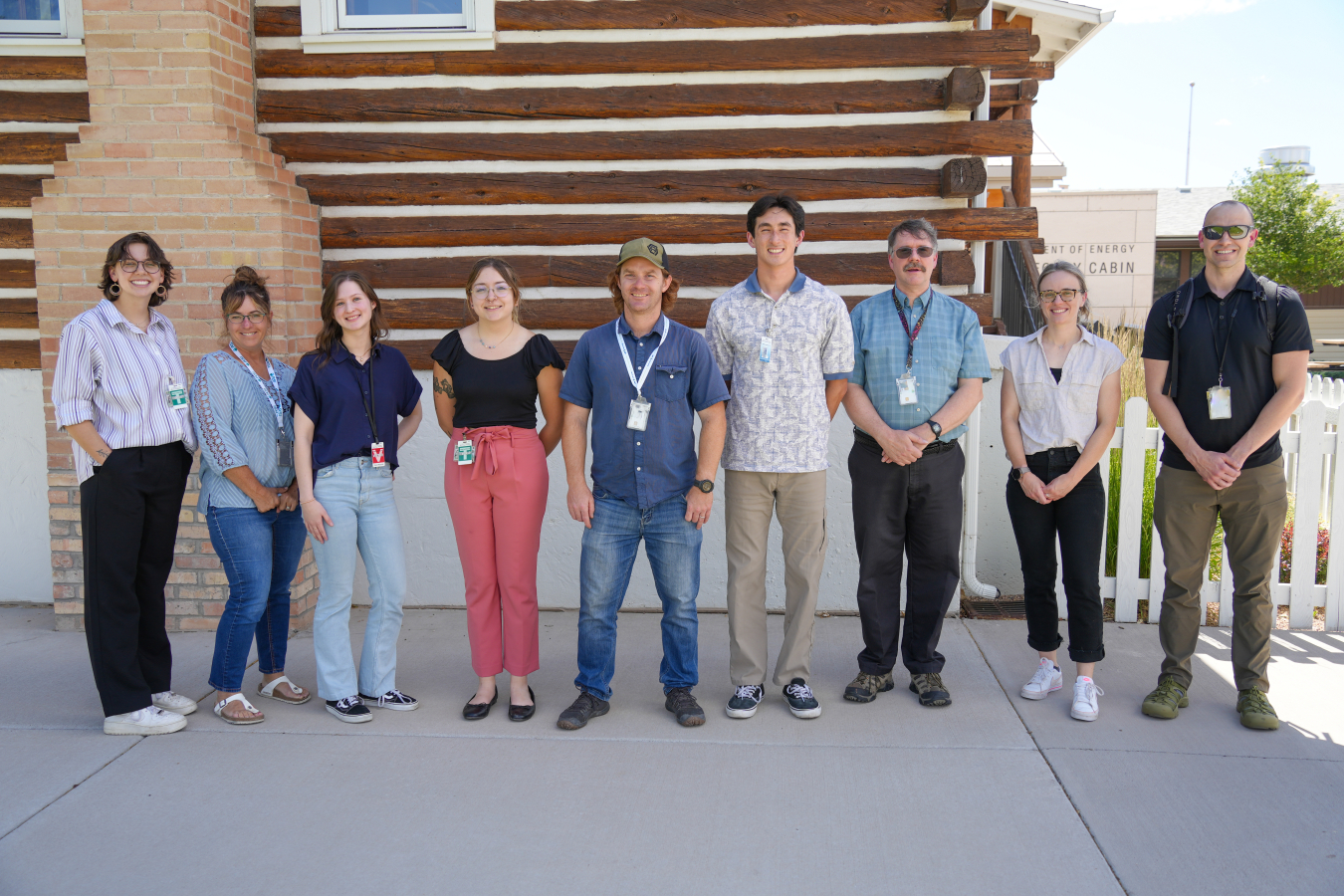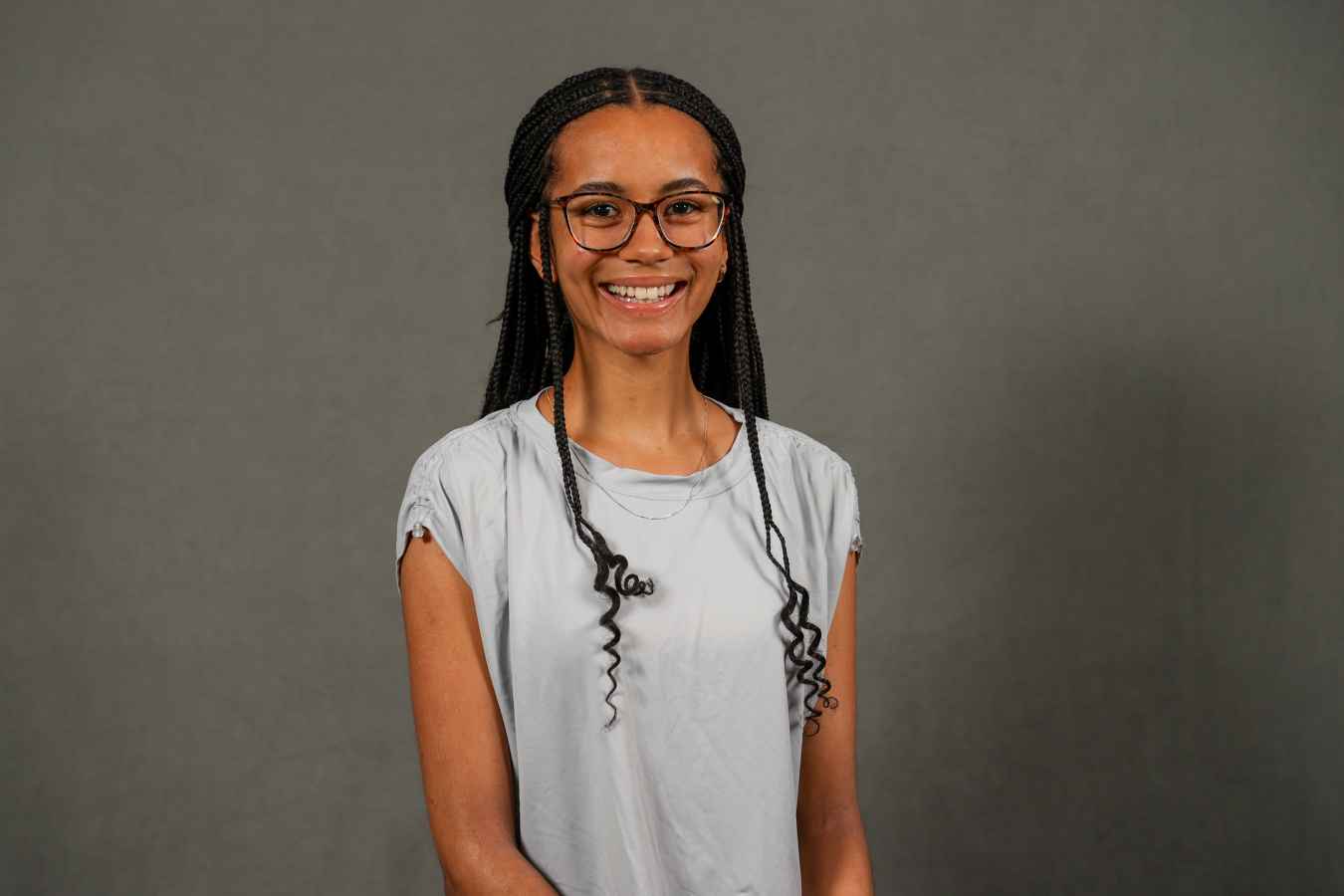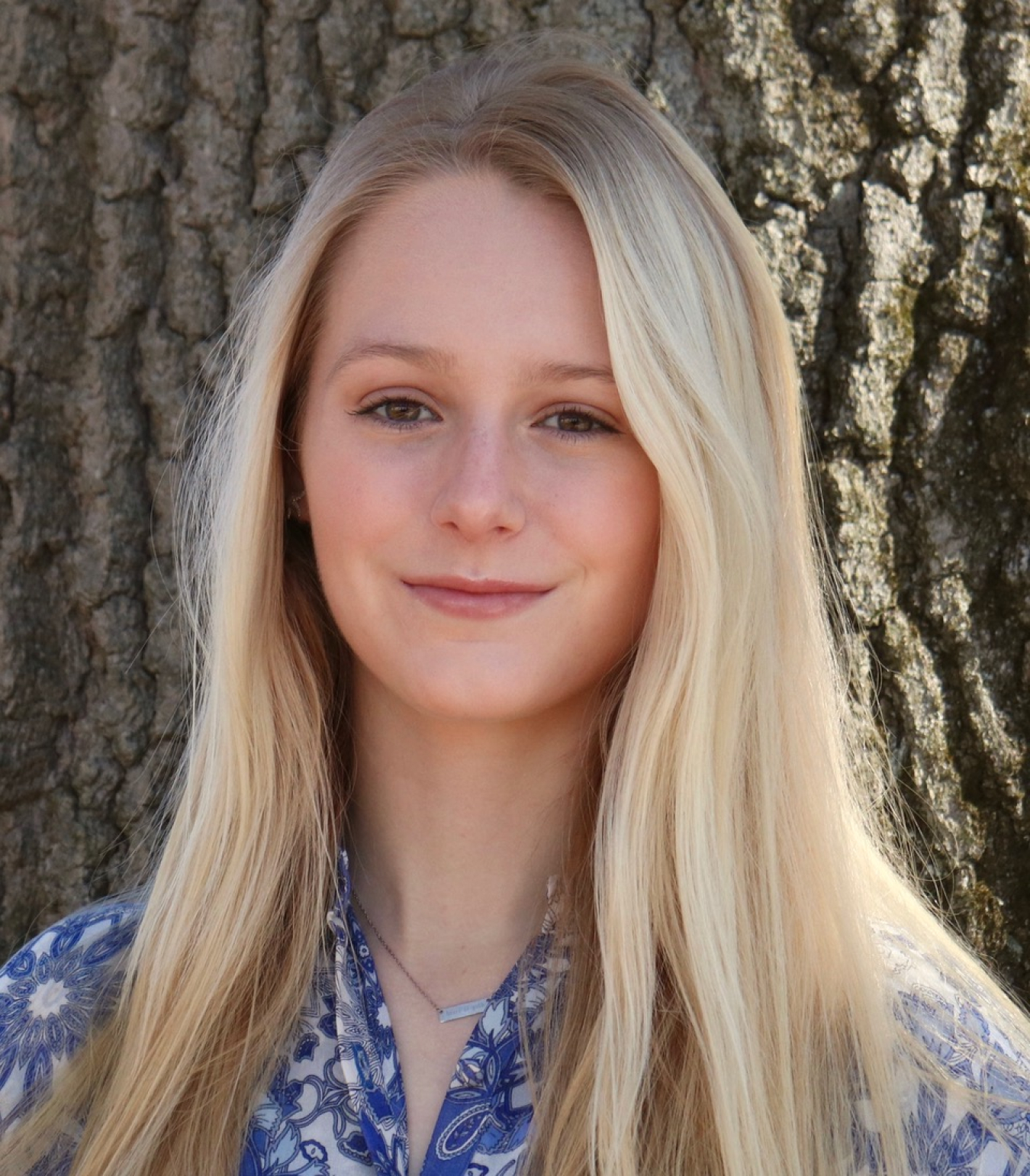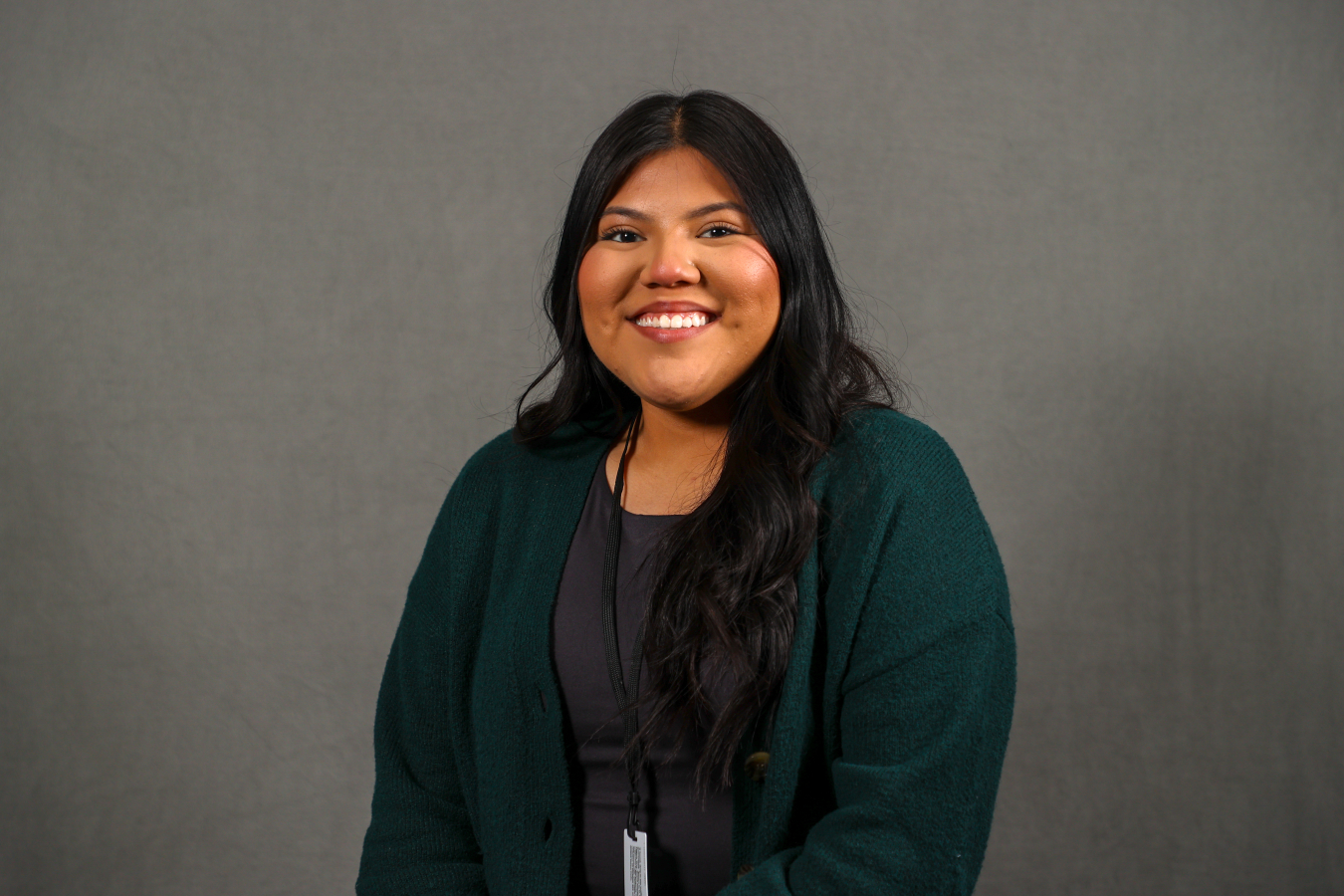The diverse projects interns worked on this summer are gearing toward LM meeting its goals
October 29, 2024
Legacy Management Support Partners, from left to right: AS&T intern Hannah Przystup; Interpretive Center Manager Richie Ashcraft; FIU Fellow Valeria Ocampo; Atomic Legacy Cabin intern Hailey Antill; Hydrogeologist Mike Morse; AS&T intern Ethan Au; Senior Geochemist Ray Johnson; Hydrogeologist Erica Evans; and AS&T Educational Collaboration Initiative Lead Chris Jarchow.
This summer, the Department of Energy (DOE) Office of Legacy Management (LM) welcomed the greatest number of interns in LM history. The Educational Collaboration initiative, the Florida International University (FIU) fellows’ program, and the Mentorship for Environmental Scholars (MES) program embraced students from five geographically diverse schools and offered them a summer filled with opportunities to learn, sharpen skills, foster connections, and take steps toward their future STEM careers. As the interns worked alongside their mentors, they also spent the summer upholding numerous LM goals.
LM's primary mission is protecting human health and the environment. Through their work on various projects over the summer, the interns learned about the effort LM undertakes to meet this goal.
Interns Valeria Ocampo and Ethan Au, both based at the Legacy Management Field Support Center (LMFSC) in Grand Junction, Colorado, spent much of their time in the lab. “From eight in the morning until lunch, I am running water through my columns,” Ocampo said. “The experiments I run help me understand the amount of uranium concentration in water throughout time.”
As the current FIU fellow onsite with a background in biochemistry, Ocampo worked closely with Au and their mentor, Ray Johnson, to complete work that aided in both her and Johnson’s studies. Ocampo’s work focused on the use of the naturally occurring mineral hydroxyapatite in different temperatures and pH levels, with the goal of testing its effectiveness for removing uranium. At the end of the summer, Ocampo created a presentation and wrote a report on her findings.
Au spent the summer conducting his own study on uranium mobility under natural anoxic conditions and helping Ocampo with her projects. Au recently graduated from Colorado Mesa University with a degree in chemistry and noted that working on this team “aided in shining light into what professional science can translate to.” He believes that learning different lab techniques laid the groundwork for fulfilling his future goal of working in a laboratory.
The two MES interns located at the LMFSC, Mikayla Bia and Jasmine Engel, also worked diligently throughout the summer to produce a report and presentation on their findings. Bia said she “returned to Grand Junction because of the good atmosphere and learning opportunities it provided that are helping me decide my future career path.”
While double majoring in environmental engineering and mathematics, Bia was referred through the Pre-College University last summer to work alongside the Defense-Related Uranium Mines team to create an ecological guide for the Navajo Nation. This summer, Bia expanded on that base and spent the summer traveling to various LM sites to catalog their ecological findings. “I was lucky that I was in good hands in regard to my mentors,” Bia said, and mentioned that she is excited for the opportunity to continue to work with them next summer.



Engel, who studies environmental science at Florida Agricultural and Mechanical University, conducted vegetative assessments at various LM sites. Alongside the work of her mentor, David Holbrook, she assessed revegetation techniques at the Grand Junction Disposal Site and compared them to the Rifle, Colorado site. Engel said the work she performed “felt like I was making an impact, because the plants will be here long term and I am contributing to long-term information.”
Another intern, Hannah Przystup, experienced a comprehensive and impactful summer. Utilizing her background in environmental science and mass communications, she crafted two distinct articles that highlighted both the efforts of her supervisors and the accomplishments of her fellow interns. Przystup split her time supporting a variety of different LM studies in the field and the lab, where she learned scientific techniques firsthand, and the office, writing about the efforts of those around her. Reflecting on her experience, Przystup said, “I had a well-rounded experience and was able to make connections in nearly every department that LM has. My time here highlights the broad scope of work that LM and LMSP accomplishes every day.”
Through their individual projects, these five interns contributed significantly to DOE’s overarching mission of protecting human health and the environment. Their work exemplifies the agency’s commitment to fostering the next generation of scientists.
In contrast to the lab and field work, interns Kaitlin McKenna and Hailey Antill had a different summer experience. McKenna studies psychology with a minor in chemistry, while Antill studies history with a minor in women and gender studies. Both interns spent the summer preserving, protecting, and sharing records and information, the second goal of the DOE.
McKenna, having spent time conducting research in a chemistry lab, was intrigued by the idea of obtaining an internship in the science field. She was sent an internship position posting from a relative who works for LMSP and McKenna, though feeling unqualified, applied for the position and received it. For the summer, McKenna spent her days with data collected from the Rocky Flat Site related to per- and polyfluoroalkyl substances (PFAS) contamination in groundwater, surface water, seeping water, and marshes.
“I am looking for any patterns that exist amongst the data,” McKenna said, “looking for a connection between two things, correlational studies, that affect the results of the concentration of PFAS.” Through McKenna’s work, she will continue working part-time with LMSP as she goes to school to continue the mission of preserving data.
Antill’s project was, perhaps, the most unique out of all the other interns’ work. Antill wrote a condition report for more than 200 artifacts stored in the Atomic Legacy Cabin’s basement. When Antill was not measuring and reporting on the condition of the artifacts, she assisted with educational programming. Alongside her mentor, Richie Ashcraft, Antill facilitated activities, led history tours, and traveled to several middle schools. Antill finished the condition reports in record time, and her work supported LM’s second goal to preserve and protect records.
The DOE’s summer internship program not only advanced the personal interests of these interns but also the broader mission of LM. Their time spent at LMFSC granted them the opportunity to find a sense of clarity of their future career paths and a deep appreciation for the mentorship and guidance they received from DOE’s finest scientists and scholars.

